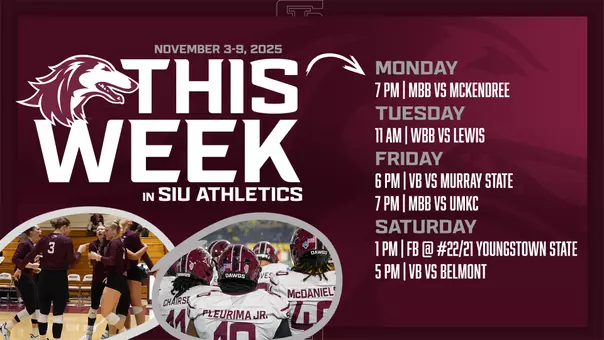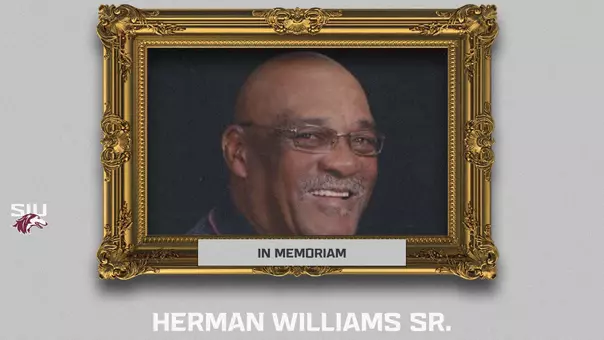Ask the AD -- March Edition
03/30/2009 | 12:00:00 | General
March 30, 2009
This is the latest installment of our monthly feature called, "Ask the AD." If you have questions for Saluki Director of Athletics Mario Moccia, feel free to submit them by e-mail.
E-Mail a question to Mario Moccia
When the arena floor is re-painted, would it be possible to have the NBA 3-point line painted on faintly, so we can see when someone is making an NBA-length 3-point shot?
With different lines already in place for the men's and women's teams, I believe doing this would really make the floor look more cluttered than it already does. I would also guess that both head coaches would oppose this, as the players might then be focused in practice and games on "NBA" 3-point shots instead of the NCAA lines.
How many athletic scholarships are available for each sport, and what is the breakdown between men and women?
This is a detailed response, but I believe it will answer your question. We offer 85 scholarships for women and 119 for men. The NCAA sets maximum limits for the total number of scholarships given in each sport. Some sports are "equivalency" sports, where each student-athlete's scholarship is assigned a value for what percentage it is of a full scholarship. Other sports are designated "head count" sports, where each student-athlete who receives a scholarship is counted as "one" toward the scholarship limit, no matter how much scholarship he/she actually gets. The chart below shows maximum scholarships by sport sponsored by SIU for 2008-09, with an "H" or an "E" following the number, to indicate whether the sport is headcount or equivalency. Some sports have limits on the number of initial (first-time) scholarships that can be given and on the total number of individuals who can receive scholarships.
Men's Sports
Baseball: 11.7 (E) (limit of 30 counters)
Basketball: 13 (H)
Football (FCS): 63 (E) (limit of 30 initial and 85 counters)
Golf: 4.5 (E)
Swimming & Diving: 9.9 (E)
Tennis: 4.5 (E)
Track &Field/Cross Country: 12.6 (E)
Women's Sports
Basketball: 15 (H)
Golf: 6 (E)
Softball: 12(E)
Swimming & Diving: 14 (E)
Tennis: 8 (H)
Track & Field/Cross Country: 18 (E)
Volleyball: 12 (H)
Please explain the RPI -- how it relates to regular season and post-season possibilities, where did it come from, how did this become the convoluted equivalent of BCS? And explain it to me like you were talking to Addie! (who played unofficial/official greeter at the library last week, both in the parking lot and at the front door! Kid's got a future in the hospitality industry--she rocks!)
Here is the most clear explanation I could find. "The Rating Percentage Index (RPI) has been used by the NCAA since 1981 to supplement the selection of at-large teams and the seeding of all teams for the NCAA basketball tournament. It is derived from three component factors: Div. I winning percentage (FI, 25%), schedule strength (FII, 50%); and opponent's schedule strength (FIII, 25%). Different weights are given to the location of the game for both the winner and loser of the game. Games against non-Division I opponents are not used in calculating the RPI. It is intended to be used in conjunction with the many other materials provided the committee and the RPI never should be considered anything but an additional evaluation tool." In doing some research, it looks like this was created by the NCAA staff to assist the selection committee. As for my daughter, Addie, it seems like even at 16 months, she has spent more time in the library than her father has at 41 years of age! I am glad she got mom's brains.
Do you envision a ring of honor in the new stadium and renovated arena for past Saluki athletes, similar to the ring of honor at the Dallas Cowboys' stadium?
We plan to incorporate the history of basketball and football in and around both facilities. We liked what Wichita State did with their renovation by creating a consistent band around the entire arena highlighting their great players. We have been kicking around plenty of ideas with graphics experts from 360 architecture but have made no final decisions at this time.
How much work will be done on the arena by the start of the 2009-2010 season?
This is still being determined. I believe there will be work, but how much of it will be visible is unclear. At the present time, we anticipate many of the concrete footings will be put in place, and perhaps new bleachers behind both baskets. We are planning to be completely out of the arena by March 1, 2010, to give the construction guys the most time possible to ensure the arena is completed in time for our first game the following season.
Are season ticket prices going to be drastically increased during construction? In other words, will we be paying top dollar to be inconvenienced by construction for an entire season of Saluki Basketball?
I do not believe that prices will be drastically increased. When establishing prices, we strive to be mindful of the economy and what the other schools in our conference are charging, as well as the number of games we play and the quality of opponents. Just like all other Universities, we have rising costs in many areas, but we are always mindful of our season and individual ticket costs.
What can be done to improve Saluki All-Access for next season? I don't mind paying for the product, but it was incredibly disappointing when I watched the SIU-UIC game though the Horizon League's website for free. I have no idea what the difference between the two are, but there is absolutely no comparison between the quality of the Horizon League's product and what SIU puts out.
There are many variables that affect the end user's experience with live streaming video. Our Director of Media Services, Tom Weber, has provided a list of some of those factors and how SIU's streaming video compares to other schools:
1. Production value: SIU shoots the game using one consumer-grade standard definition camera. Schools that have in-house video production typically shoot with at least three cameras in high definition. This requires a producer, mixing console and direct scoreboard feed. We have none of these capabilities at SIU Arena or any of our facilities. We will, however, be adding those components as part of Saluki Way.
2. Encoding: Regardless of how a game is shot, it must be fed to a computer, encoded and transmitted to a distributor. The two most important factors in encoding are the bit rate and the codec (encoder). Bit rate refers to the size of the feed. A high bit rate will give you a cleaner picture. We could stream at television quality from the arena, however, the vast majority of users would not have the bandwidth to watch it. We stream at 500 kbps, which provides acceptable quality and reaches nearly all users, regardless of whether they have DSL or cable. We have chosen a bit rate that the majority of people can use. Next year, we are considering having two separate feeds for basketball, one at 300 kbps and one at 600+ kbps. We have the bandwidth to do it in the arena, although we don't have enough at the stadium. Regarding the codec, we use Flash, which is a mainstream method of streaming. Some school's use Silverlight. There are plusses and minuses to both. With all other variables being the same, only a trained eye could tell the difference between the two.
3. Streaming provider. This is actually the least important factor. All they do is transmit the finished product. We contract with Stretch Internet, which rents server time from various sources throughout the country. Their job is to accurately estimate the number of potential users who will access a game and make sure they rent enough space. They made a mistake during the UNI basketball game (in which we were doing a dual feed) and did not rent enough space.
4. End user's network. Assuming the feed has been successfully transmitted to Stretch and placed on the streaming server, there is still potential for problems on the end user's network. Many home users have high-speed cable or DSL. Sometimes, a company will claim high speeds, but in reality, may consistently deliver only 200-300 kbps. Such users will have nothing but trouble with our feed. It's important to understand the difference between on-demand video (such as youtube) and live video streaming. On-demand video is simply a finished file that your computer is accessing. Live streaming video is not a file, but a steady stream of bits coming to your computer.
Looking back at the past year, Tom tells me there were problems with several broadcasts. The first half of the Evansville road game did not air because of weather damage to our satellite dish. There was a game where hackers shut down the University's network for periods of time. There was a game when a video cable was accidentally unplugged for about five minutes. We also had audio problems early in the season, because the new radio network signal is not very strong. Rest assured that when we notice problems, we try to resolve them as quickly as possible. We also expect significant improvements in production quality when the new facilities come on-line.
Does the athletic department pay out of state tuition to the University for out of state athletes? If so, how much will the new policy of surrounding-state students paying in-state tuition help the athletic department?
Yes we pay out-of-state rates for anyone classified as such. Based on our current mix of student-athlete residency, I expect the new tuition policy to save approximately $23,000 to $25,000 per year, with each progressive class saving cumulatively ($95,000 - $100,000 at the end of 4 years). If this policy were to apply to all student-athletes currently enrolled, we would save $94,895 on this year's tuition bill.




